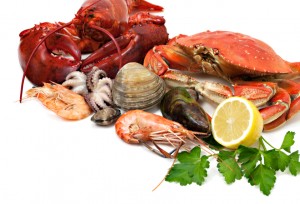Serving seafood for your holiday gathering? The you may want to check out the tips on serving it safely from the U.S. Food and Drug Administration (FDA).
 Fish and shellfish are good sources of protein and nutrients, but handled improperly, they can cause illness. The first step in seafood safety is selecting wisely. Here’s what the FDA recommends:
Fish and shellfish are good sources of protein and nutrients, but handled improperly, they can cause illness. The first step in seafood safety is selecting wisely. Here’s what the FDA recommends:
Selecting Fish
Don’t buy fish that isn’t refrigerated or displayed on a thick bed of fresh ice. Don’t buy fish that has a strong odor. Do look for fish with clear, slightly bulging eyes. Do select fillets that have firm, shiny flesh that springs back when pressed. Don’t buy fish that have milky slime in their gills. Don’t buy fillets that are discolored or drying around the edges.
Selecting Shellfish
Do buy shrimp with translucent, shiny flesh and little or no odor. Do look for tags on sacks or containers of live shellfish (in the shell) and labels on containers or packages of shucked shellfish. Don’t use clams, oysters, and mussels if their shells are cracked or broken. Do perform a “tap test.” Live mussels clams, and oysters will close up when their shells are tapped. If they fail the tap test, don’t buy them. Do check for leg movement on live crabs and lobsters. should show some leg movement.
Cooking Seafood
Do use a food thermometer to make sure your seafood should be cooked. Most seafood should be cooked to an internal temperature of 145ºF. I
Serving Seafood
Do remember to keep hot seafood hot and cold seafood cold. Do put smaller amount on serving dishes so you can keep the rest refrigerated or warming. Do keep cold seafood on ice or serve it throughout the gathering from platters kept in the refrigerator.




